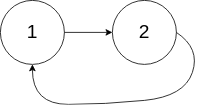Description
https://leetcode.com/problems/palindrome-linked-list/
Given a linked list, determine if it has a cycle in it.
To represent a cycle in the given linked list, we use an integer pos which represents the position (0-indexed) in the linked list where tail connects to. If pos is -1, then there is no cycle in the linked list.
Example 1:
Input: head = [3,2,0,-4], pos = 1 Output: true Explanation: There is a cycle in the linked list, where tail connects to the second node.

Example 2:
Input: head = [1,2], pos = 0 Output: true Explanation: There is a cycle in the linked list, where tail connects to the first node.

Example 3:
Input: head = [1], pos = -1 Output: false Explanation: There is no cycle in the linked list.

Explanation
If any of the node has been visited, the linked list has a cycle.
Python Solution
# Definition for singly-linked list.
# class ListNode:
# def __init__(self, x):
# self.val = x
# self.next = None
class Solution:
def hasCycle(self, head: ListNode) -> bool:
visited = set()
while head != None:
if head not in visited:
visited.add(head)
else:
return True
head = head.next
return False
- Time complexity: O(N).
- Space complexity: O(N).
I found that solution very popular and helpful
https://www.youtube.com/watch?v=sfP64T6SmaY&ab_channel=EricProgramming
/** Java Solution **/
/**
* Definition for singly-linked list.
* class ListNode {
* int val;
* ListNode next;
* ListNode(int x) {
* val = x;
* next = null;
* }
* }
*/
public class Solution {
public boolean hasCycle(ListNode head) {
if(head==null||head.next==null||head.next.next==null)
return false;
ListNode fast=head;
ListNode slow=head;
while(fast!=null && fast.next!=null){
fast=fast.next.next;
slow=slow.next;
if(fast==slow)
return true;
}
return false;
}
}